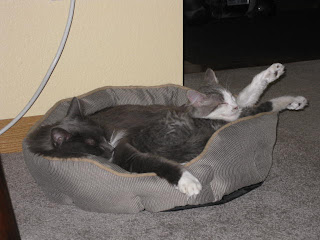The following is a blog entry from Sandi, who recently adopted a kitten from Care Animal Hospital during our most recent Lucky Paws "Adopt-a-Thon."
I have a 1 ½ year old cat named Riley who, except for the occasional "bad bities", is an awesome cat. I've been thinking about getting a second cat for a while and since I'm home more these days I thought--no time like the present! I believe in trusting my gut, so I took my time finding the right kitten and was open to either a male or female. I finally found the right kitten who was an 11 week old female. Stella (the kitten formerly known as Tasha Yar) was part of a litter found in the wild and was fostered for several weeks by Dr. Paige Garnett. I brought her home in a kitty carrier and triumphantly placed it in the center of the living room. Stella's picture is shown below.
Riley thought it was great to see the kitty carrier until he spotted Stella. His tail and body then bushed out to twice their normal size and he began circling the carrier, his ears turned back and low. Stella started meowing after about 20 minutes, so I took her out of the carrier to walk around...big mistake! Riley started to chase her and immediately began pouncing and biting. I had a spare bedroom made up for Stella with her own food, water, kitty litter box and small bed. I spent some time with her alone in her new room until she got sleepy, and then I left her in the room with the door closed. After a minor panic attack, I immediately got on the internet and started searching for material about "integrating cats".
I discovered a great web site. It was super helpful with examples of cat body postures, pictures of actual cat integrations and very comprehensive instructions for successful integrations. These sequential steps include: isolation (from each other, not from people), scent familiarization, room swapping, visual familiarization, developing positive familiarization, short supervised visits, separation at signs of hostility, longer supervised visits, limited free mingling and finally free mingling full time. Additional tools that were helpful include having a spray bottle or squirt gun on hand for times that play gets too rough, lots of toys, and the use of Feliway, a natural pheromone spray that you can pick up at Care Animal Hospital. In particular, I found it helpful to have two toys (one for each hand and cat). This allowed each cat some supervised playtime where they didn't have to fight over an individual toy, but could still see the other cat playing and get used to them.
I learned that the bad news was that I had mistakenly skipped right to the last step resulting in overly stressed cats. The good news was I could begin again at step one (isolation) and follow each step (for as long as necessary) before continuing on to the next step. In my case, I discovered it was necessary to back up and repeat the first few steps a couple of times before Riley and Stella were truly ready to continue on.
The main lesson I learned was it really takes time and patience to integrate a new cat into the home. Cats adapt to change at their own pace. Even the most social "resident" cat can feel very threatened and resort to "warfare" tactics to protect their turf.
With Riley and Stella it took 3 ½ weeks to go from high stress drama to sleeping in a cat bed (together!!!!) on a cold, snowy afternoon. There were several days/weeks I thought it was never going to work out, but I'm so grateful that I stuck it out and gave each cat the necessary time to adjust. I have to say that it's really worth the time and effort that goes into the integration process when you see them actually playing "nicely" together and taking naps in a sunny spot side-by-side.


